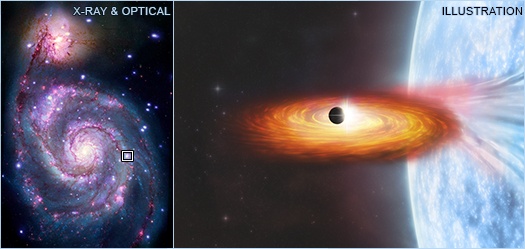Discovery of the first exoplanet candidate in X-ray binary M51-ULS-1 in the spiral galaxy Messier 51 (M51), also called the Whirlpool Galaxy using transit technique by observing dips in brightness at X-ray wavelengths (instead of optical wavelengths) is pathbreaking and a game changer because it overcomes the limitation of observation of dips in brightness at optical wavelengths and opens up the avenue for the search of exoplanets in external galaxies. Detection and characterisation of sayari in external galaxies has significant implications for search for extra-terrestrial life.
"Lakini kila mtu yuko wapi?” Fermi had blurted out, way back in the summer of 1950, pondering why there is no evidence of any extra-terrestrial life (ET) out in the nafasi despite high probability of its existence. Three quarters of the century past that famous line, still there is no evidence of any life anywhere outside the Earth, but the search continues and one of the key components of this search is the detection of sayari outside the solar system and its characterisation for possible signatures of life.
Zaidi ya 4300 exoplanets yamegunduliwa katika miongo michache iliyopita ambayo inaweza au isiwe na hali zinazofaa kusaidia maisha. Wote walipatikana ndani ya nyumba yetu galaxy. Hapana exoplanet was known to be discovered outside the Milky Way. In fact, there is no evidence to support the idea of presence of planetary system in any external galaxy.
Scientists have now reported ugunduzi of a possible exoplanet candidate in an external galaxy for the first time. This extrasolar sayari is in the spiral galaxy Messier 51 (M51), also called the Whirlpool Galaxy, situated at a distance of about 28 million light years away from home galaxy Njia ya Milky.
Kawaida, a sayari is detected by way of observing eclipse it produces when it transits in front of its nyota wakati kuzunguka around thus blocking the light emanating from the nyota (transit technique). This event is observed as temporary dimming of the star. Search for an exoplanet involves searching for dips in the light of a nyota. The other method of detection of sayari is by radial velocity measurements. All exoplanets have been detected using these techniques in our home galaxy at relatively short intra-galactic distances in the range of 3000 light years.
However, searching for dips in the light at larger inter-galactic distances to detect exoplanets outside the Milky Way is an uphill task because an external galaxy occupies a small area in the sky and the high density of stars does not allow study of an individual star in sufficient details to enable detection of signatures of a sayari. As a result, search at optical wavelength in an external galaxy was not feasible until now and no exoplanet outside our home galaxy could be discovered. The latest research is pathbreaking and a game changer because it seemingly overcomes this limitation by observing dips in brightness at X-ray wavelengths (instead of optical wavelengths), and opens up the avenue for the search of exoplanets in other galaxies.
X-ray binaries (XRBs) in the external galaxies are considered to be ideal for the search of exoplanets. These (i.e., XRBs) are a class of binary stars made up of a normal star and a collapsed star like white dwarf or a nyeusi shimo. Wakati nyota ziko karibu vya kutosha, nyenzo kutoka kwa nyota ya kawaida hutolewa kutoka kwa nyota ya kawaida kuelekea nyota mnene kwa sababu ya mvuto. Kwa hivyo, nyenzo ya urutubishaji karibu na nyota mnene huwaka moto kupita kiasi na kung'aa kwenye miale ya X inayoonekana kama vyanzo angavu vya X-ray (XRSs).
With an idea to detect sayari kuzunguka X-ray binaries (XRBs), the research team searched for dips in the brightness of X-ray received from the bright X-ray binaries (XRBs) in three external galaxies, M51, M101, and M104.
Timu hatimaye iliangazia mbinu ya X-ray binary M51-ULS-1 ambayo ni mojawapo ya vyanzo angavu vya X-ray katika galaksi ya M51. Kuzama kwa mwangaza wa X-ray iliyopokelewa na darubini ya Chandra ilionekana. Data kuhusu kuchovya katika mwangaza ilichunguzwa kwa uwezekano mbalimbali na ikapatikana kuwa inafaa kwa ajili ya kusafirishwa na sayari, uwezekano mkubwa wa ukubwa wa Zohali.
This study is also novel for carrying out the search of exoplanets successfully for the first time at X-ray wavelength. On the broadest level, this landmark ugunduzi of exoplanet outside our home galaxy expands the scope of search of exoplanets to other external galaxies, which has implications for the search of extra-terrestrial intelligent life.
***
Vyanzo:
- Di Stefano, R., Berndtsson, J., Urquhart, R. et al. Sayari inayowezekana katika galaksi ya nje imetambuliwa kupitia upitishaji wa X-ray. Astronomia ya Asili (2021). DOI: https://doi.org/10.1038/s41550-021-01495-w. Inapatikana mtandaoni pia kwa https://chandra.harvard.edu/photo/2021/m51/m51_paper.pdf. Toleo la awali linapatikana https://arxiv.org/pdf/2009.08987.pdf
- NASA. Chandra Anaona Ushahidi wa Sayari Inayowezekana katika Galaxy Nyingine. Inapatikana mtandaoni kwa https://chandra.harvard.edu/photo/2021/m51/
- NASA. Sayansi -Vitu - X-ray Binary Stars. Inapatikana mtandaoni kwa https://imagine.gsfc.nasa.gov/science/objects/binary_stars2.html
- Schwieterman E., Kiang N., et al 2018. Saini za Kiumbe za Exoplanet: Mapitio ya Ishara za Maisha Zinazoweza Kutambulika kwa Mbali. Astrobiology Vol. 18, No. 6. Imechapishwa Mtandaoni tarehe 1 Jun 2018. DOI: https://doi.org/10.1089/ast.2017.1729






































